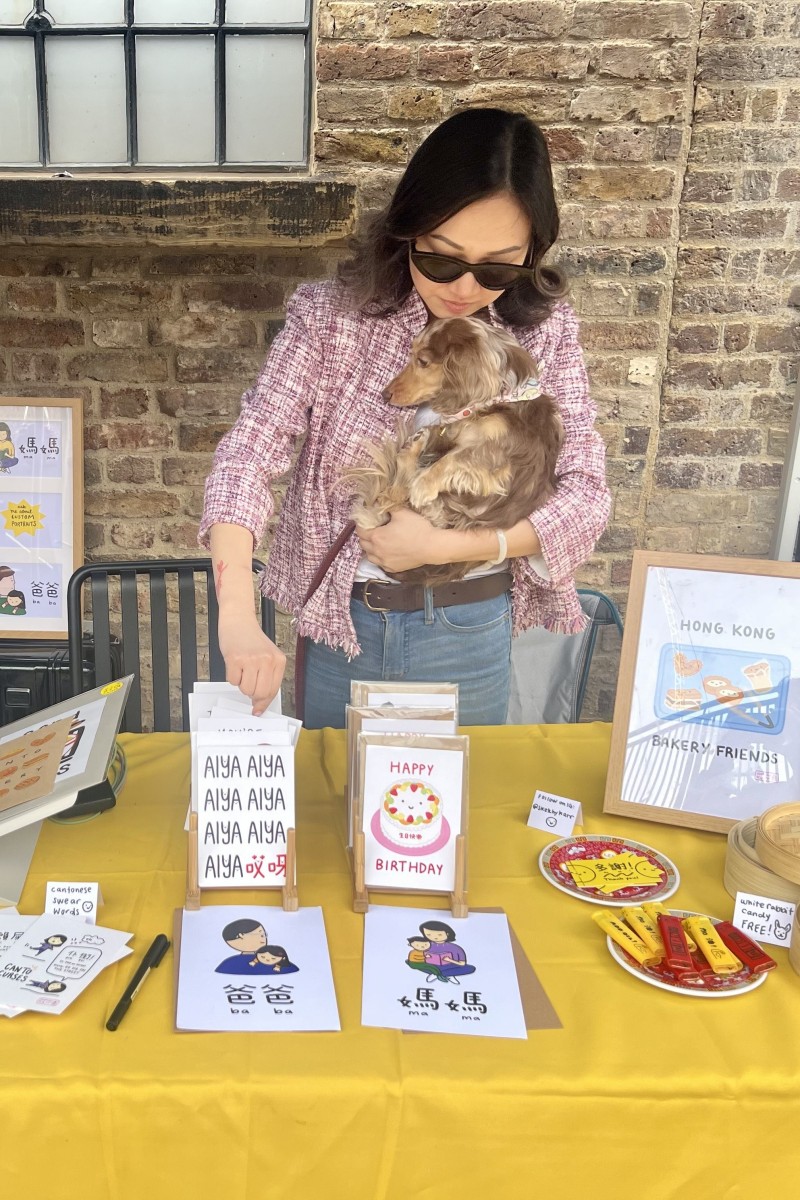
Artist who left Hong Kong for Britain illustrates her nostalgia for the city’s culture on Instagram as Sketchykarr
- With smiling street snacks, minibuses and more, the 31-year-old’s drawings explain popular Cantonese slang and give other Hongkongers abroad a taste of home
- Every week, Talking Points gives you a worksheet to practise your reading comprehension with questions and exercises about the story we’ve written
 Kar, who moved from Hong Kong to Britain nine years ago, occasionally takes part in London’s art markets to sell her work. Photo: Handout
Kar, who moved from Hong Kong to Britain nine years ago, occasionally takes part in London’s art markets to sell her work. Photo: HandoutWhat makes someone a “bad Asian”? What does it mean if something is “big wok”? These are just a few topics that artist Kar*, known as Sketchykarr on Instagram, addresses with her cute, playful drawings.
Featuring smiling minibuses and White Rabbit candy, Kar’s nostalgia-fuelled drawings explain popular Cantonese slang and illustrate the struggles of being a third-culture kid. The 31-year-old lived in Canada before relocating to Hong Kong as a kid and has called Britain home for the last nine years.
“I ... moved to Hong Kong when I was 10 – I think those were my formative years,” she said. “Hong Kong really influenced my art and who I am as a person. I’ve always been straddling different cultures.”
Why she draws about Cantonese culture
As a child, Kar always carried a pencil and paper, recalling “my mum did it to keep me occupied”. It was how she retreated from the busyness of Hong Kong.
The youngster also went to drawing classes for a while but stopped because she couldn’t draw what she wanted. “In Hong Kong it was like, ‘copy this, copy that’ ... I couldn’t do my own thing.”
She continued making art but said she stopped “drawing with intention” when she was 14.
For Hongkongers abroad, clothing brand’s Cantonese slang is taste of home
After moving to London for graduate studies, Kar didn’t restart her art until the Covid-19 pandemic began – a time when “everyone picked up their passion projects again”, she said. In January 2021, she made her first post for her doodle account on Instagram, which now has more than 30,000 followers.
Her drawings of Cantonese words and slang, accompanied by a short explanation of its origins, are a way to share her experiences and appreciation of the language. She also dissects phrases so that those who don’t speak the language can easily understand.
There’s a simple reason she focuses on Cantonese phrases and culture in her art: nostalgia.
“I was kind of missing home and missing Hong Kong, and I couldn’t visit because of the pandemic,” said Kar, who creates these drawings in her free time.
Posting about Hongkongers’ home-cooked food to record city’s memories
She also uses her account to comment on Hong Kong culture and share her experiences.
One example is a post that touches on situations that may seem 冇問題 (mou5 man6 tai4), meaning unproblematic, but are actually 有問題 (jau5 man6 tai4), problematic. The first slide of the post features two of Hong Kong’s classic blue, red and white plastic bags.
“When you’re told to not talk back, but you just want open communication and honest conversation,” she wrote in the picture. Other slides discuss issues like body dysmorphia and mental health.
What Sketchykarr means to Hongkongers abroad
Kar’s work gives other Hongkongers abroad the chance to feel seen and reconnect with their roots.
“Hongkongers are good at uplifting and promoting each other,” she said. “Most people who follow me or buy my art might have some connection [to the city], and people who don’t have a chance to learn more.”
The artist added that her page allowed her to teach others about Cantonese culture, which is vital amid a rise in anti-Asian racism in Western countries.
Sup sup sui: Your go-to guide for Cantonese internet slang
The response to her art has generally been positive, and people comment on her posts with their experiences and appreciation of the language.
“People share their stories, and it’s nice that they can open up and tell me things. I try to answer everyone’s questions and reply to comments,” Kar said, adding that she often gets messages from people thanking her for her work and encouraging her to continue.
Art has also helped Kar on a personal level.
“It’s a good way to not deal with other stuff in the world,” she said. “It’s good self-care time. It’s time for me to be alone, to do something and create something.”
“It’s also unintentionally given me a tool to connect with people – I’ve met many friends because of art.”
*Last name withheld at interviewee’s request
Click here for a printable worksheet and interactive exercises about this story.
